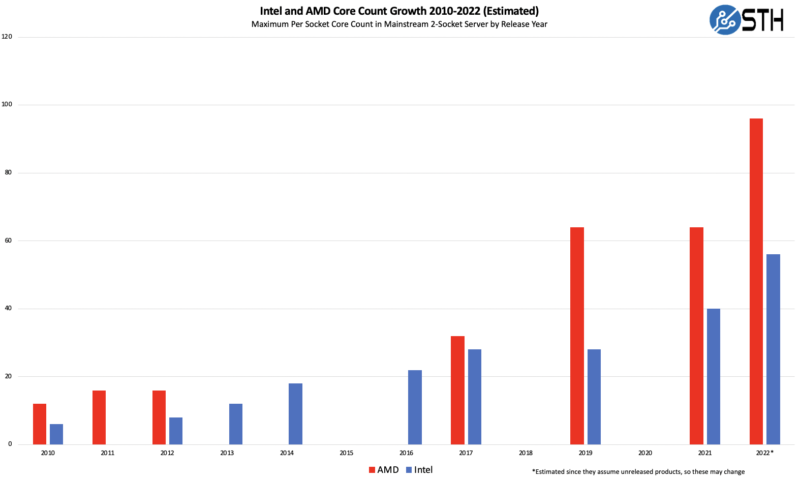Last week I made a chart for a talk that I am giving at Netreo NUGGET 2022 this week. I thought it may be interesting for STH readers as well. The basic premise I wanted to discuss was how much bigger server CPUs are getting. We have had variations of this in the past, but I wanted to update it for the 2022 generation of servers to show the scale of the change we are seeing.
AMD and Intel 2P Server Core Count Growth 2010-2022
If you remember the The 2021 Intel Ice Pickle How 2021 Will be Crunch Time piece from 2020, we actually had a version of the core count by generation.
The point of the 2020 chart was to discuss the pre-Ice Lake generation gap between Intel and AMD CPUs.

With the 2022 version, I wanted to focus instead on yearly releases. Instead of having years like 2015 and 2020 where we did not get new CPUs, I wanted to just use the years where new chips were released. Also, I realized I messed up on the Opteron 6100-6300 release dates in the older charts. Those were different chips since the cores were not exactly 1:1 for Intel cores at the time. So in this one, instead of drawing trendlines that require each year to be represented, I wanted to look at the growth just on each new step.

Here we are using a maximum of 96 cores for AMD’s Genoa generation and 56 cores for Intel’s Xeon Sapphire Rapids generation. We are noting these as estimates since the chips are not released so we used the biggest core counts we have found public references to. Vendors may adjust core counts before release. Here is a version with all of the years represented, even when there were no releases.

The impact of the chart is that our jump from 2021 Milan to Genoa will be around 50% higher core counts. Ice Lake to Sapphire is a 40% jump in core counts. On a historical basis, this is a huge leap. It also means that the core count jump in 2022’s generation of CPUs will be enough to take a “Naples” generation 2017-2018 or even early 2019 CPU and consolidate an additional CPU socket. In Q2 2019, the largest CPU you could get was the AMD EPYC 7001 Naples chip at 32 cores. In Q4 2022, the largest CPU will be three times that.
Unlike what we saw in 2019 when the AMD EPYC 7002 Series Rome arrived, core counts are going up. AMD has already discussed Bergamo at 128 cores per socket. The Ampere Altra Max is already at 128 cores per socket, but those Neoverse N1 cores are more akin to a pair rivaling a Milan core with SMT. That is much in the same way it was in 2010-2012 for AMD.

From 2023 and beyond, core counts will accelerate rapidly. This core count acceleration will have massive impacts on the industry. Even fewer systems will run a single workload meaning that when we look at performance it will be most useful in the context of running multiple workloads simultaneously versus today’s focus on single workloads as is the model with benchmarks like SPEC CPU2017. When we discuss CXL, DPUs, and other technologies, this is to support these more expansive systems.
Final Words
We will likely have a piece introducing the Netreo NUGGET 2022 talk later this week. Our original plan was to post the video to our YouTube channel, but Netreo will be uploading it so I am working on a different version for STH. Still, this concept of rapidly accelerating core growth is one that will have massive impacts on the industry. We often discuss numbers but seeing them charted also helps. My hope is that our readers find this useful as well.
Note: 2022-09-12 Embedded some caption text in the charts to make them easier to read.





Do you expect the various disaggregation mechanisms(along with higher core counts, of course) to suppress demand for 2+ socket systems by taking some tasks away from the CPUs and making things like shared memory more accessible outside the chassis; or would you expect some potential movement in the opposite direction; if various smarter-but-more-expensive peripherals end up making it attractive to try to drive down the effective cost per core of providing your CPUs with various DPUs and accelerators and the like?
I’d assume that something like CXL adoption will be a fairly obvious hit against arrangements that were historically multi-socket just because they needed the memory controllers; but I’d also imagine that, if the expectations of what a baseline set of platform features looks like go from just basic NICs to more capable peripherals the effective cost/core of the classic cheap 1 socket may rise faster than that of 2+ socket systems.
The graph is mis-labeled. It shows “core count”, not “core growth”.
“Gigaflops per core/socket” would be interesting since GHz and IPC has changed a lot over time, too
Why 2-socket still matters…
might be useful to summarize, unless it’s obvious to the intended audience.